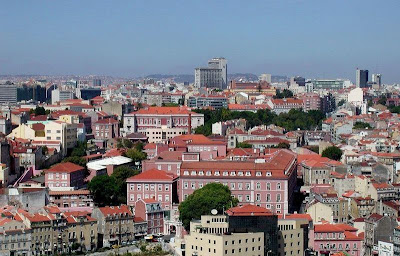 Charles I had the most influence of any monarch on this land. Escaping from the plague in town, he vistied Richmond, and realized this was land he could hunt. In 1637, ignoring all complaints, he turned it into a hunting park containing some 2,000 deer, and enclosed them inside a 13-km (8-mi) long, brick wall.
Charles I had the most influence of any monarch on this land. Escaping from the plague in town, he vistied Richmond, and realized this was land he could hunt. In 1637, ignoring all complaints, he turned it into a hunting park containing some 2,000 deer, and enclosed them inside a 13-km (8-mi) long, brick wall.  The deer and the hunt changed the look of the park. Mature trees - some of which still stand today - were pollarded to protect them from being eaten. Ponds were dug to provide water. Later on, planned vistas were designed, and small woods added - fenced for protection. Today some 350 fallow deer and 300 red deer still inhabit the park and continue to shape the landscape. Whilst you relax, you might see exotic looking birds flitting from tree to tree - this is home to a large poputlation of parakeets.
The deer and the hunt changed the look of the park. Mature trees - some of which still stand today - were pollarded to protect them from being eaten. Ponds were dug to provide water. Later on, planned vistas were designed, and small woods added - fenced for protection. Today some 350 fallow deer and 300 red deer still inhabit the park and continue to shape the landscape. Whilst you relax, you might see exotic looking birds flitting from tree to tree - this is home to a large poputlation of parakeets. Only with bicycle, you can earlier to go all around the park, head west to Ham House. Built for Sir Thomas Vavasour in 1610, it has a fascinating history. Between 1626 and the end of the century the house, by this time under different ownership, was transformed into a luxuriously furnished villa, and much of its decor and contents can still be seen today. Standing on the banks fo the Thames, Ham House also has magnificent gardens that include a 17th-century orangery and what is believed to be the oldest Christ's thorn bush in the United Kingdom.
Best time to go: a sunny day between mid-March and the end of October.
Finding an accommodation nearby: online booking hotels in London.



 Pisa boasts not just the legendary leaning tower, but also several other attractions, and good transport links to other parts of Italy. Smaller Tuscan destinations which are popular with holidaymakers include Lucca, San Gimignano (a forest of medieval towers on a hill) and the wine-producing Chianti area.
Pisa boasts not just the legendary leaning tower, but also several other attractions, and good transport links to other parts of Italy. Smaller Tuscan destinations which are popular with holidaymakers include Lucca, San Gimignano (a forest of medieval towers on a hill) and the wine-producing Chianti area.



 Don't miss: the authentic Japanese Tea House in Heale Gardens, built over a trout stream, which then flows under a red Nikko brige...
Don't miss: the authentic Japanese Tea House in Heale Gardens, built over a trout stream, which then flows under a red Nikko brige...




